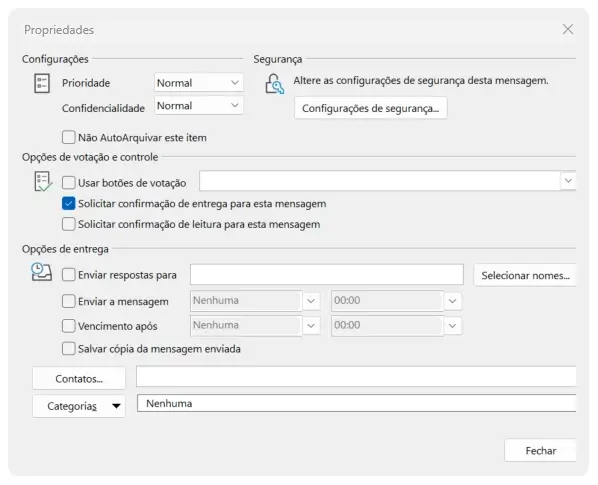How to know if an email has been delivered? This information is indispensable, both for those sending a personal message and for professionals working on email communication campaigns.
There are also those who send commercial proposals, urgent communications and other corporate documents. In other words, knowing whether an email has been delivered is essential for any communication to work.
In this sense, undelivered emails can result in lost information, wasted investment in campaigns and delays in company projects.
In the following paragraphs, we will explore the different ways of checking whether an email has been delivered, from basic methods to more advanced tools.

Table of Contents
How to tell if an email has been delivered: the basic method
Asking the recipient for a read confirmation is one of the most widely used ways of knowing if an email has been delivered.
This functionality is available in providers such as Outlook, Apple Mail and others, but not all of them. Therefore, before applying this method, check that your email provider offers this service.

Read confirmation works like this: you send an email and when the recipient opens it, they receive a message asking if they want to confirm that the email has been read. In other words, if the recipient agrees, the sender receives a notification.
How to set up read confirmation on ISPs
Each email provider has its own configuration. We’ve listed some of the most commonly used providers below.
As we mentioned earlier, not all providers offer the option of read confirmation, and Gmail is one of them.
However, you can, for example, install a Mailsuite extension on your Chrome browser to see if your message sent via Gmail has been delivered. We’ve provided a whole paragraph on this subject in the course of this article.
For now, here’s how to set up read confirmation in Outlook, Thunderbird and Apple Mail.
Read confirmation in Outlook
- Open Outlook.
- Click on “New Email” to start a new message.
- Click on the “Options” tab.
- Check the “Request read confirmation” box in the “Tracking” section.
- Write and send your email.
How to tell if an email has been delivered by Thunderbird
- Open Thunderbird.
- Click on “Write” to start a new message.
- Click on the “Options” tab in the menu bar.
- Select “Request read confirmation”.
- Write and send your email.
Configuring Apple Mail for read confirmation
- Open Apple Mail.
- In the terminal, copy and paste the command below to enable read confirmations:
defaults write com.apple.mail UserHeaders ‘{“Disposition-Notification-To” = “[email protected]”;}’
- Replace “[email protected]” with your email address.
- Restart Apple Mail.
- Write and send your email as normal.
How to tell if an email has been delivered using email tracking tools
There are email tracking tools that provide methods for verifying the delivery of emails.
Here are some of the best known:
Mailsuite
This is an email tracker that lets the sender know if the email has been delivered and read.
To use it, go to mailsuite.com, add the tracker as a Chrome extension or download the application.
- To add it as an extension, click on the “Add to Chrome” button. Confirm installation by clicking on “Add extension”.
- To install the application, click on the “Install on Gmail” button.
As this method is also available for Outlook, you have the option of clicking the “Install on Outlook” button.
Important
After installation, Mailsuite will ask for permission to access your email account. Log in with the account you want to use.
Mailsuite will guide you through a configuration system. Follow all the instructions until the process is complete.
Once the procedure is complete, every time you send an email, Mailsuite will automatically add the tracker.
This way, you’ll see status icons next to the emails you send (one gray check for sent, two green checks for read).
Yesware
This tracker works for Gmaill and Outlook, offering real-time notifications of when the recipient opens an email.
The tool is available as a Chrome extension and also allows you to schedule emails to be sent at specific times.
To use it, go to yesware.com and follow the instructions to open an account. The tool also offers a dashboard that shows the weekly performance of the emails sent. This way, you can see more details about how many and which emails were opened.
Mixmax
It’s a good tool for those who send corporate emails. It combines email tracking with scheduling features. It can be installed as a Chrome extension.
To use it, go to mixmax.com, enter the “Products” tab and select “Track email activity”.
Email marketing tools
Email marketing tools such as Mailchimp, Hubspot and others also offer email tracking, but the data is more complete as these are platforms used by professionals.
Among the information offered by these platforms is a bounce report. This document details all delivery failures.
Bounce: when the email is not delivered
Bounces are emails that fail to be delivered to the recipient and go back to the sender. Basically, there are 2 reasons for delivery failures. See what they are below.
Soft bounces are momentary problems that, when resolved, allow the email to resume its delivery path.
Examples of soft bounces include the recipient’s box being full, the recipient’s server having an unstable connection, configuration problems, among others.
Hard bounces, on the other hand, are permanent delivery failures. In other words, it means that the email doesn’t exist, or has been deactivated, or has been mistyped (so it doesn’t exist), among a host of other reasons capable of permanently invalidating an email address.
While we’re on the subject of soft bounces and hard bounces, take a look at the article we’ve prepared on the subject for more details.
And how do professionals find out how many bounces they have on their mailing lists? In order to reveal all failures in email delivery, the bounce report is an important tool for senders who want to achieve good deliverability rates.
How to know if an email has been delivered: analyzing information from email marketing reports
The bounce reports provided by email marketing tools are essential to know if the email has been delivered.
SafetyMails is integrated with the largest email marketing platforms on the market. SafetyMails’ email verification service removes bounces from lists, making them clean so that you can improve the quality of contacts and increase the deliverability of campaigns.
With the information from the bounce reports, you can take corrective action to optimize your campaigns. In this way, senders work to ensure that their messages reach as many recipients as possible.
See what information you’re likely to find in a bounce report:
- Bounce rate: this information comes first in most reports. It is the percentage of emails that were not delivered in relation to the total number of emails sent.
- The identification of the email addresses that returned as bounces and their classification (soft or hard).
- The reasons for the bounce (what caused the delivery failure).
- Date and time the bounce occurred.
- And the bounce history, which is the record of previous delivery attempts to the same email addresses (this is very useful for identifying patterns).
Good deliverability practices
In order for emails to be delivered efficiently, it’s important to adopt some deliverability best practices.
A clean contact list is essential. Make sure you remove invalid or inactive email addresses regularly. This is done through an email verification service. The results ultimately reduce the bounce rate and improve the sender’s reputation.
Setting up security authentications required by providers (SPF, DKIM and DMARC) helps prevent your emails from being marked as spam. These authentications validate that messages are being sent from genuine sources.
Finally, sending relevant, quality content increases the likelihood of emails being opened and replied to. So avoid using words that might remind you of spam, or that suggest too much urgency in the subject line. Also, personalize your messages to create a connection with your recipients.
Pay attention to the opening rate
The open rate is an important metric for monitoring campaign performance. However, technical elements aimed at increasing data privacy are changing this parameter.
As you saw at the beginning of the article, read confirmations require user authorization for tracking. As a result, open rates may change.
Something else that also interferes with open rates is Apple’s security system (Apple MPP), which hides the opening of emails. The result is inaccurate data.
There is also the possibility of configuring the account not to open images. As a result, there is no way of recording opens.
Finally, there are anti-spam filters that remove tracking pixels before the message reaches the recipient.
All these elements can mask opening rates, causing misunderstandings. And knowing this, it is recommended that professionals monitor the performance of their campaigns by the click-through rate, which does not change.
It is through this that the level of engagement can be measured. In short, to reach conversion, the lead needs to go through engagement.

Conclusion
Requesting read confirmation and using advanced email monitoring tools are different ways of knowing if your messages are reaching their destination.
Adopting one of these forms of verification (read confirmation for personal emails or email monitoring tools for professionals), in addition to adopting deliverability best practices, can significantly improve your chances of success.
FAQ
What are the ways of knowing if the email has been delivered?
Read confirmation is the most basic method used for personal emails. However, this service is not offered by all email providers. However, there are options for tracking tools, such as Mailsuite, Yesware and Mixmax.
Professionals, on the other hand, who work with mass mailings can rely on the services of automated platforms, which in turn offer bounce reports, among other deliverability metrics.
What are good email deliverability practices?
Clean contact lists are essential. Senders who work with lists that don’t contain bounces or invalid emails achieve good deliverability rates and build credibility with ISPs.
Security settings are also very welcome, as anti-spam filters are trained to find senders who don’t have the required authentications. Finally, sending content that is relevant to the user increases the chances of generating good open rates. All this is reflected in a constant improvement in email deliverability.



